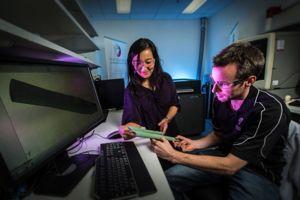 Have you ever stopped and thought about the individual musical notes that make up our favorite songs? What if the keys on the piano didn’t sound exactly like they actually do? What if there was a way to fill in the gaps between individual musical notes, providing us with new sounds which could help us create new forms of music? All of these are questions that have plagued music composer and researcher at Wollongong University, Terumi Narushima — so much so that she looked toward 3D printing to find some answers.
Have you ever stopped and thought about the individual musical notes that make up our favorite songs? What if the keys on the piano didn’t sound exactly like they actually do? What if there was a way to fill in the gaps between individual musical notes, providing us with new sounds which could help us create new forms of music? All of these are questions that have plagued music composer and researcher at Wollongong University, Terumi Narushima — so much so that she looked toward 3D printing to find some answers.
For several years, Narushima has been working on creating flutes which can play different sounds; sounds which are not included among the 88 piano keys on a standard piano. For those of you who do not know, each key on a keyboard is a single “semitone” away from the one next to it. While many people think of a semitone as being the smallest incremental change in sound possible, this actually is not the case.
“When you go to school and study music you’re told the smallest interval possible is a semitone,” explained Narushima. “But I’m interested in the sort of notes you can get that fall between the cracks of the keys of the piano. A lot of the music in the world doesn’t fit into those nice neat steps.”
“Rather than us saying, ‘OK here are the tunings available’, eventually we’d like to be able to say, ‘What tuning would you like on your instrument? We’ll come up with a 3D model for you that we can either print for you or maybe they might be able to print at home,” Narushima explains. “If you change one parameter in the design it ends up affecting everything else. Compared with the acoustics of, say, violins, which we are getting a very good understanding of, it seems with wind instruments like flutes there is still a lot of trial and error.”
3D printing has allowed Narushima to create flutes which play the microtonal notes that the typical flute or other instrument can not. This means that her flutes are capable of playing completely new types of music, songs which would not have been possible without the changes that she makes to the design of her instruments. 3D printing has provided her with a means for doing so, as the technology allows for changes to be made to the shape of these flutes in a way that traditional manufacturing are not able to achieve.
As for the potential that the combination of 3D printing and instrument making provides, Narushima believes that this same technology will be able to be used on larger wind instruments such as trumpets and saxophones as well. It will also allow for instruments to be made specifically for the musician who will be playing it.
It will certainly be interesting to observe how Narushima’s instruments are put to use in the coming years. Perhaps one day soon we will see more mainstream artists creating works of art unlike anything we have heard before, thanks in part to Narushima and 3D printing. What do you think about this idea? Discuss in the 3D Printed Microtonal Flutes forum thread on 3DPB.com.
Subscribe to Our Email Newsletter
Stay up-to-date on all the latest news from the 3D printing industry and receive information and offers from third party vendors.
Print Services
Upload your 3D Models and get them printed quickly and efficiently.
You May Also Like
Metal Powder Supplier Elementum 3D Added to $46B Air Force Contract
Elementum 3D, a Colorado-based developer and supplier of metal powders used in additive manufacturing (AM), announced that the company has been added to the vendors list in the fourth on-ramp...
Ursa Major Lands $28.6M AFRL Deal for 3D Printed Draper Engine Flight Demo
The US Air Force Research Laboratory’s (AFRL’s) Rocket Propulsion Division at Edwards Air Force Base has awarded a $28.6 million contract to Ursa Major for follow-on work related to the...
3D Printing Financials: Rocket Lab’s Record-Breaking Year and Over 20 Launches Coming in 2025
Rocket Lab (Nasdaq: RKLB) closed 2024 with its best year yet. The company launched more rockets, signed more contracts, and expanded deeper into spacecraft and satellite production than ever before....
US Air Force Taps Beehive to Study 3D Printed Jet Engines
Propulsion 3D printing firm Beehive Industries secured a contract from the U.S. Air Force Life Cycle Management Center through SOSSEC. SOSSEC is a company that manages Other Transactions Authority (OTA)...



































